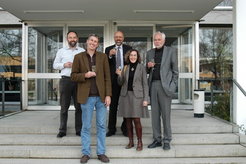Highlights 2011
Research news from the division Plasma Edge and Wall
Most Cited Articles in Journal of Nuclear Materials
(21.11.2011)
The review article by J. Roth et al. on “Recent analysis of key plasma wall interactions issues for ITER” with many international co-authors including several from IPP is currently the most cited article published in the last 5 years in the Journal of Nuclear Materials.
Published in the PSI Proceeding of PSI-19 in 2009, the article was until December 5, 2011 cited in 101 articles.
Joachim Roth, E. Tsitrone, A. Loarte, Th. Loarer, G. Counsell, R. Neu, V. Philipps, S. Brezinsek, M. Lehnen, P. Coad, Ch. Grisolia, K. Schmid, K. Krieger, A. Kallenbach, B. Lipschultz, R. Doerner, R. Causey, V. Alimov, W. Shu, O. Ogorodnikova, A. Kirschner, G. Federici, A. Kukushkin and EFDA PWI Task Force, ITER PWI Team, Fusion for Energy, ITPA SOL/DIV

From left to right: Dr. Rudolf Neu (IPP), Dr. Karl Krieger (acting Task Force Leader, IPP), Dr. Joachim Roth (IPP), DR. Emmanuelle Tsitrone (CEA Cadarache), Dr. Volker Philipps (FZ Jülich).
Journal of Nuclear Materials, 390-391 (2009) 1-9:
Recent analysis of key plasma wall interactions issues for ITER
